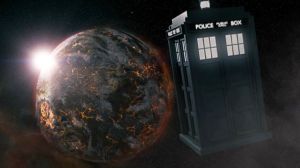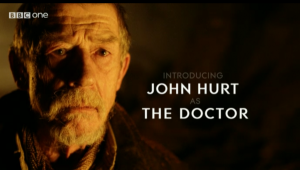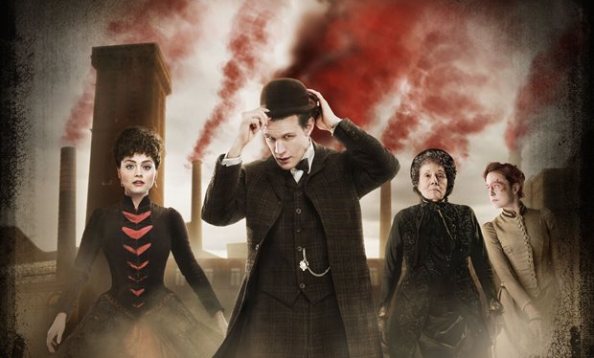Overview
As I wrote last week, when Doctor Who features big industrial spaceships I’m already happy – The Girl in the Fireplace and The Satan Pit are two episodes where this trope is used best – but this episode also gave us a journey through the bowels of the universe’s most mysterious blue box, making it by far my favourite of the the series so far. In the end it was an episode for the fans – but hey, I’m a fan so I loved it.

Source: BBC
Full review – huge spoilers
Opening scene and cue the aforementioned industrial spaceship, an enormous salvage vessel searching the galaxy for junk, scrap and hopefully treasure. On board a young man uses his bionic eyes to get a reading of a ship that keeps appearing and disappearing. At first I thought these were just implants but then another crew member called him an android – thankfully my Whovian radar is still functioning adequately and my first guess would later be proved right.
On the TARDIS the Doctor and Clara have an argument about the fact that Clara and the TARDIS are not exactly getting on very well. The Doctor tries to mend the rift between his two favourite girls by having Clara try piloting the ship. Then the salvage ship disturbs the test drive by capturing the TARDIS with a ‘magnetic grab’, which also causes a violent reaction from inside the console room. During the usual explosions and thrashing about, Clara notices a small silver object rolling towards her that she picks up, burning her hand.
We return after the opening credits to see the TARDIS being passed along by huge mechanical arms (with the help of some unfortunate Doctor Who CGI) into the salvage yard where the crew try to crack it open. The Doctor makes his entrance with a friendly, “It’s rude to whisper” as three crewmen debate whether to dump the TARDIS and his body. After quickly explaining that he knows they have used an illegal piece of tech to grab his ship he promises the men the salvage of a lifetime if they come with him to help find Clara.
We then cut to Clara who wakes up covered in TARDIS parts and nursing her burnt hand. As she wonders around dodging fireballs she starts to notice that the burn looks like it might be something more than it first appears.
Back with the Doctor and the crewmen. Now we of course knew that he wouldn’t actually give them the TARDIS, but trapping them inside and setting a self-destruct timer so they are forced to help does seem a little harsh. He warns them of their mistake with my favourite line from the episode – “Don’t get into a spaceship with a madman, didn’t anyone ever teach you that?”
Then the episode got really interesting for fans as we got to stroll around some of the deepest parts of the TARDIS with Clara – before needing to run around them as she is chased by horrible burning lava zombies. We see a little Time Lord’s crib, the famous swimming pool and, of course, the library! Oh, the library! For someone who loves a bit of book porn this was Doctor Who heaven. Luckily, instead of wading through copies of Agatha Christie, Clara went straight to the History of the Time War and finds out the Doctor’s real name – a fact she will of course forget as she must do for the story arc of the series to continue.

Source: BBC
Whilst Clara is catching up on her reading, the least savoury crewman is of course doing something unsavoury by stealing some living metal from a glowing tree that has the ability to make any other machine. The Doctor warns of a TARDIS tantrum but the episode wouldn’t have been interesting if the crewman just did as he was told and put it back.
After hiding behind the Encyclopedia Gallifrey, which is contained in an interesting liquid word technology, Clara is chased out of the geek paradise by the lava zombie. And, speaking of lava zombies, we then see the rather slow-witted crewman, who has been tasked by his unsavoury brother to strip the console room apart, killed by one of these burning baddies – oh well, that was bound to happen so it was hard to feel sorry for him.
The Doctor, the unsavoury and unhuman crewmen are now stuck in the labyrinth that the TARDIS has created within itself and Clara also feels these effects as she finds herself in an echo of a control room that she can’t escape. The Doctor duly saves her and, just before she is fried by one of the lava creatures, reveals that the self-destruct countdown was just a rouse (using the “wiggle some buttons trick”) to frighten the crew into helping. But again that wouldn’t have been dramatic enough so we find out that the TARDIS is about to explode for real because of the effects of the magnetic grab and now everyone has to go straight to the centre of the ship to stop this from happening.
On the way Clara gets lost again (of course she bloody does) and encounters some ghostly memory versions of herself and the doctor as the past starts to leak in around them. After finding each other aand running away to avoid the TARDIS impaling them with metal spikes, they come across the crewmen and see that the android has already been skewered, which forces the unsavoury crewman to admit that the android is really his brother with a few implants (I knew it!) and that the android thing was all some sick joke to allow the unsavoury brother to be captain – brotherly love indeed.
Then things got weird and interesting. As our group find their way to the exploding star kept in a permanent state of decay that powers the TARDIS (you have to love Time Lord engineering), they are then trapped by the lava zombies. The crewman’s scanner then uncovers the secret that the Doctor has been hiding – that at least one of the zombies is a future version of Clara (yes, this is the weird and interesting part). So, the Doctor brought Clara to the TARDIS to keep her safe from whatever happens to her but seems unable to stop whatever it is that is causing her horrible end – confusing, but in a good way. After they fight off some of the zombies and touch each other exactly when the Doctor warns them not to (silly secondary characters), the crewmen brothers meld together into the creepy conjoined zombie that they have just killed – timey wimey stuff I suppose.
The Doctor and Clara run out of the chamber and stop just before going over a chasm. The Doctor explains the history of his encounters with her and her other versions – well he might as well if they’re about to explode – to try and force her into telling him who she is, but she genuinely doesn’t know. After a nice hug the Doctor realises that the chasm is just the TARDIS trying to frighten them and they take a leap of faith into the heart of the TARDIS that has already exploded but is temporally held in stasis for the Doctor to fix. He despairs before noticing the backwards writing on Clara’s hand “BIG FRIENDLY BUTTON” and figures out how pin-point the right moment through the music (thankfully there was a reason for it) and rewrite time so that the whole episode doesn’t happen – well at least we get to remember that awesome library.
Before the Doctor does the rewriting and kills this version of himself in the process, Clara tells the Doctor that she knows his name but he stops her from revealing it – damn you Doctor! We then go back to the moment of the magnetic grab. The Doctor hits the big friendly button on the remote and time is rewritten with some unusual side-effects i.e. the unsavoury brother is now kinder to the still-thinks-he’s-an-android brother.
Overall this was a great episode for one that didn’t happen. The side characters were more interesting than the ususal expendable drones, and although there wasn’t a particularly strong narrative, the tour around the TARDIS and teasing nods at Clara’s mystery were enough to please any fanboy or girl. This journey gets a strong 7 out of 10.
Next week
‘The Crimson Horror’ – a Victorian mystery with Strax, Vastra and Jenny. I predict there will be the usual fun high-jinks from this threesome but I’m not optimistic about the plot from what we saw from the trailer. If something more is revealed about the Clara mystery then I’ll be happy but my expectations are low.














